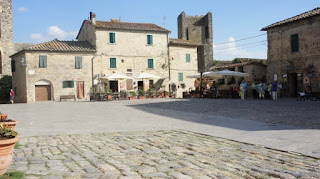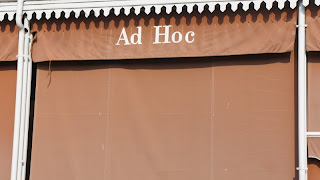I haven’t yet written about our Turkish experience. I had wanted to go to Turkey since I was a child and read about it in an encyclopaedia I received for Christmas when I was about 10. It always sounded so mysterious and intriguing, so when we were putting the itinerary in place, Turkey was included.
We arrived mid afternoon in Istanbul. The airport is some way out of the city and the drive to our hotel was a real experience. I thought we were going to die a number of times but we arrived in one piece.
The hotel was horrible- dirty and small and very smelly. We had to climb over the bed to get in or out of it and the bathroom hadn’t been cleaned in years. There were 5 sleazy guys- we called them the Lounge Lizards- who swanned about in shirts & ties in the reception area, which was the size of a normal loo. Anyway... enough about the accommodation.
 |
| At Blue Mosque with Haggia Sofia in background |
We had a “free” tour with a guide the following day. He was very knowledgeable and pleasant but of course we had the hard sell re carpets. However, as Bill wanted one, that was OK by me because I really didn’t want to be sorting out where to go or if they were reliable traders.
The sights in Istanbul are amazing. The noise and heat are something else. The reason I have left writing about this city till now is because I wanted to be fair in my thoughts. Tiziana and Ugo, our Italian friends, lived there for 6 years and taught at the international school. They loved the city and the atmosphere and the lifestyle but I really can’t say that it’s my cup of tea, Turkish or otherwise.
The history was fascinating. It’s where East meets West and is a true bridge between the two cultures. As we’re museum lovers, we spent hours reading about life over the centuries and their history is long and rich. And so much of it includes people from “this” side of the continent as well-lots of crossing over.
We had never been to a mosque and we were staying in the vicinity of many. The Blue Mosque is possibly the most famous but there is another one, the Haggia Sophia, that we liked more, possibly because of its interesting background. It had been variously Muslim and Christian over the years and although it’s Muslim now, there are still many Christian icons and frescoes in the building.
 |
| Blue Mosque from the roof top restaurant |
Of course, the Muslims pray loudly many times a day, starting at around 4 am! Mary, my sister, was quite right when she said it sounded like the Imams were going “Blah, blah, blah, blah, blah white bummmmmmmmmmmm !!!!! And it did! Our hotel was directly opposite a mosque and it was terribly unfortunate that the singer there didn’t have a clue about pitch. I have never heard anything so out of tune! Some of the singers were quite good. Progess has arrived though, and now the chanting is recorded so you don’t get to see the little man standing on the top of the church with his megaphone.
No trip to Istanbul is complete without a visit to the Grand Bazaar. It was huge! Kenin, our guide, said there would be over4 4 000 stalls in the area! And they sold everything from household goods to food and clothes and just anything you could think of. Apparently it’s the place to shop when you’re setting up house as a young couple. We O’D on the herbal teas for some reason. Hope we remember what they are when we get them home. At least they’re keeping everything in my post smelling nice!
 |
| Turkish delight on left and dried fruits on the right |
Another part of Istanbul that Kenin took us to was the Basilica Cistern which was built by 700 slaves in the 6th Century as the water system for the Great Palace of Constantinople. The Cistern is an underground chamber that measures 138m by 64.6m- about 9,800 squares (105 000 sq ft) in area, capable of holding 80 000 cubic metres of water. The ceiling is supported by 336 marble columns each 9 m high and arranged in 12 rows of 28 columns. The majority of the columns in the cistern appear to have been recycled from the ruins of older buildings.
Kenin said that when he was at school, the class was brought to the Cistern and they boated around in there. Now, after walking down 55 steps, visitors are able to move about on walkways over the water. The cistern is very cleverly lit and classical music is played over a PA system. There’s even a cafe in there! It was one of the best experiences we had.
 |
| The Basilica Cistern |
 |
Bill and I in the Cistern. The column we are
standing near has the head of Medusa carved on it. |
Another great experience was the mausoleum that housed the royal bodies. OU know by now, my fascination with these areas and this was something special. The Sultan was buried with his family around him and when I asked if the children there had died from plagues or other incurable illnesses of the time, Kenin said that that was the case but also, because the Sultan had many children, and only one of the boys could succeed him, they often fought amongst themselves to see who would be the strongest and so it was actually, at times, a process of elimination!
 |
Tombs in the Royal Mausoleum
Green seems to be a favourite colour
We also visited the Palace to see how the nobility lived and they certainly lived well. We felt sorry for the eunuchs, but apparently they were highly thought of and were really a powerful force in government and as advisors to the Sultan. The queues were something else so we prioritised where we went.
Eunuchs' Courtyard at Topkapi Palace. The guy featured just happened to be there at the time. I don't think he's a eunuch, but then, I didn't ask so who knows?
Bill in the Concubines' Courtyard Topkapi Palace. Wishful thinking about the life of a sultan, maybe? |
As dinner wasn’t served at our hotel- & even if it had been we wouldn’t have eaten there- we wandered into the city and found a lovely restaurant on top of another hotel so we ate there every night. It was the season of Ramadan while we were there and every night the restaurant reserved most of its tables for Muslim families coming to break the fast. They always ate the same food- a sugary drink to help with getting their body glucose back up and then many small dishes which had some sort of religious significance and finally a sweet that was like a baklava. By the time we were leaving, after three nights, we were like family and so we were given one of these sweets as a gift from the staff. It was lovely.
Blue Mosque from the restaurant where we had dinner each night. We could see forever from here and had a great view over the water as well.
Most of the world seemed to be in Istanbul when we were there- though we could actually say that about most places in Europe. The thing that surprised us nicely was that at no time did we feel unsafe.
 |
| Lanterns in Grand Bazaar |
And so we will always remember our experience of East Meets West as one of learning about a totally different culture but also as one which we are in no hurry to repeat. As we said, Istanbul is a nice place to visit-once!
















































